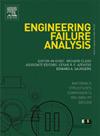全尺寸复合潮汐涡轮机叶片失效的法医学调查
IF 5.7
2区 工程技术
Q1 ENGINEERING, MECHANICAL
引用次数: 0
摘要
潮汐涡轮机的叶片承受着与风力涡轮机不同的独特的严酷、剪切为主的载荷,但它们的失效机制仍然知之甚少。在这项研究中,我们报告了由玻璃纤维增强聚合物(GFRP)、碳纤维增强聚合物(CFRP)和铸铁制成的潮汐叶片的首次全面失效调查。使用定制的实验室装置,叶片进行了26次静态测试和17次疲劳测试,其中包括三个液压致动器和鞍座固定装置。应变计、位移传感器和数字图像相关(DIC)相结合来跟踪局部变形和损伤。人工缺陷加速了损伤进程,在最终失效之前产生了大约97000次疲劳循环。出现了两种主要的破坏模式:在设计载荷为216%的准静态载荷下,压力蒙皮与根连接之间的粘结破坏;在设计载荷为119%的疲劳载荷下,压力蒙皮与根连接之间的粘结破坏。随后的静力试验表明,残余强度下降到仅为原设计载荷的68.8%。这些发现强调了粘接界面在叶片完整性中的关键作用,以及内肋在保持结构性能方面的贡献。虽然局部刚度受到损伤的影响,但整体刚度在很大程度上保持不变,这加强了研究潮汐涡轮机叶片长期性能退化和失效演变的重要性。本文章由计算机程序翻译,如有差异,请以英文原文为准。
Forensic investigation of failure in a full-scale composite tidal turbine blade
Tidal turbine blades endure uniquely harsh, shear-dominated loads that distinguish them from wind turbines, yet their failure mechanisms remain poorly understood. In this study, we report the first full-scale failure investigation of a tidal blade made of glass fibre reinforced polymer (GFRP), carbon fibre reinforced polymer (CFRP) and cast iron. The blade was subjected to 26 static tests and 17 fatigue tests using a bespoke laboratory setup with three hydraulic actuators and saddle fixtures. Strain gauges, displacement transducers, and digital image correlation (DIC) were coupled to track local deformation and damage. Artificial defects accelerated damage progression, yielding roughly 97,000 fatigue cycles before ultimate failure. Two dominant failure modes emerged: de-bonding between the pressure skin and root connection under quasi-static loading at 216 % of design load, and bondline failure between pressure and suction skins under fatigue at 119 % of design load. A subsequent static test showed residual strength drop to only 68.8 % of the original design load. These findings highlight the critical role of bond interfaces in blade integrity and the contribution of internal ribs in maintaining structural performance. While local stiffness was affected by damage, global stiffness remained largely intact, reinforcing the importance of investigating long-term performance degradation and failure evolution in tidal turbine blades.
求助全文
通过发布文献求助,成功后即可免费获取论文全文。
去求助
来源期刊

Engineering Failure Analysis
工程技术-材料科学:表征与测试
CiteScore
7.70
自引率
20.00%
发文量
956
审稿时长
47 days
期刊介绍:
Engineering Failure Analysis publishes research papers describing the analysis of engineering failures and related studies.
Papers relating to the structure, properties and behaviour of engineering materials are encouraged, particularly those which also involve the detailed application of materials parameters to problems in engineering structures, components and design. In addition to the area of materials engineering, the interacting fields of mechanical, manufacturing, aeronautical, civil, chemical, corrosion and design engineering are considered relevant. Activity should be directed at analysing engineering failures and carrying out research to help reduce the incidences of failures and to extend the operating horizons of engineering materials.
Emphasis is placed on the mechanical properties of materials and their behaviour when influenced by structure, process and environment. Metallic, polymeric, ceramic and natural materials are all included and the application of these materials to real engineering situations should be emphasised. The use of a case-study based approach is also encouraged.
Engineering Failure Analysis provides essential reference material and critical feedback into the design process thereby contributing to the prevention of engineering failures in the future. All submissions will be subject to peer review from leading experts in the field.
 求助内容:
求助内容: 应助结果提醒方式:
应助结果提醒方式:


